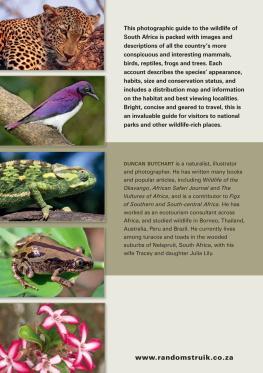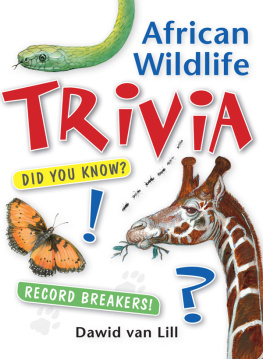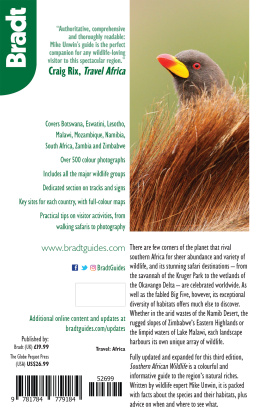
DEDICATION
For my family and friends.
And the Lord God took man and put him in the Garden of Eden to tend and guard and keep it.
GENESIS 2:15.
INTRODUCTION

As a child I spent annual holidays in the Kruger National Park and this nurtured my love for animals and wild places. On my first visit, I had a glimpse of a leopard as it leaped from a rock onto an impala ram, stunning it, before rushing off at the approach of our car. We watched as the impala slowly regained consciousness and ran off, with the leopard in hot pursuit. This was the start of a long fascination with Africa, one that would eventually take me from the boardroom to the bushveld.
Over the years, my interest in both wildlife and photography became an obsession. However, the time I could devote to pursuing my passion was limited by my commitment to our family motor business. It was only after the company was sold, in 1989, that I finally had the opportunity to work full time on a project I had begun a few years previously, namely my book Leopard.
The sights, sounds and smells of the bush took on a new dimension as I shed my business suits and smart sedans for khakis and a four-by-four. The elation I felt as I headed for Mala Mala Game Reserve to continue my leopard studies and photography was heightened by the realization that, at last, I had the freedom to explore Africas great wild places, fulfilling the dream that had dominated my mind for so many years.
To protect our childrens future we must work together in caring for our fragile earth and, simply, stop taking it for granted. It is, after all, the only one weve got.


After giving birth, a zebra mother keeps all other zebras at bay for several days, giving her foal time to imprint on her and learn the unique pattern of stripes that will enable them to locate each other in the herd at any time.

A Goliath Heron will wait for long periods beside water for an opportune moment to strike at a passing fish. In the five hours that I waited alongside the Sabie River for this photograph, the heron caught two tiger fish.

Giant Kingfishers, the largest of the family in southern Africa, feed primarily on small fish that they catch by diving into rivers and other bodies of water.

After a rain shower, a lioness licks her cubs coat. This serves the dual purpose of bonding and drying the cub. Lionesses form strong bonds within a pride and cub survival is highest when reproduction is synchronized in order to facilitate communal care.

Primates are the most socially active mammals and their resemblance to humans makes them a treat to watch as they go about their daily activities.


The migration of wildebeest between Kenya and Tanzania is one of the greatest wildlife shows on earth. The wildebeest population grew from 250,000 animals in 1961 to 1.3 million in 1977 and, contrary to expectations, the numbers have remained constant since then, being held in check by the availability of dry season grazing and natural culling by predators.
Wildebeest numbers build up for hours on the banks of the Mara River until, finally, one brave animal takes the plunge, to be followed by thousands of others as the epic river crossing begins. Forty-five minutes later, it can all be over.

Leopards have a very wide habitat tolerance, ranging from rainforests to deserts. Although they have a lifespan of up to 20 years in captivity, it is typically shorter in the wild, around 12 years. I was fortunate to study one particular leopard in Sabie Sands Game Reserve in South Africa, that lived for 17 years, the oldest recorded lifespan of a leopard in the wild.

Hippos like to submerge themselves in water because their thin skin is vulnerable to sunburn. Contrary to belief, they are not expert swimmers, preferring to float and push themselves along with strides on the river bottom. On land, they are extremely agile and can run at 30 kilometres per hour. Their aggressive nature and powerful jaws pose a threat to humans.

There are relatively few black rhino left in Kenya but, during my trips to the Masai Mara National Park, I regularly saw this cow and calf. Rhino are selective feeders, and vulnerable to malnutrition because of their sedentary habits.
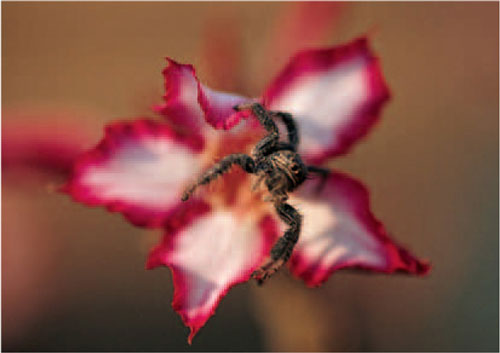
Spiders, a class of arthropod, have four pairs of legs and a body in two principal sections; the cephalothorax (combined head and thorax) and the abdomen. Sixty-three spider families occur in Southern Africa.
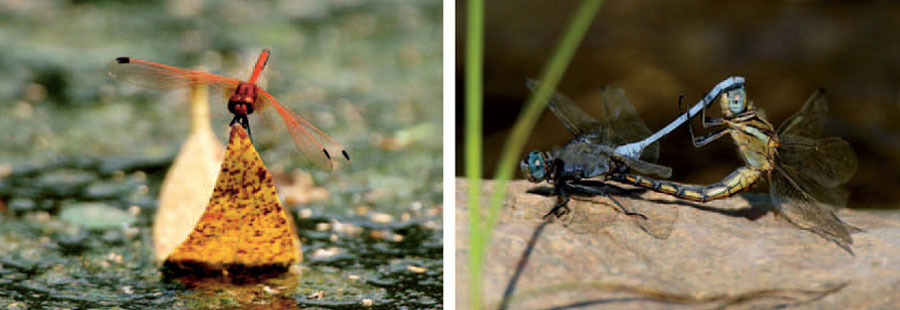
Skimmer dragonflies belong to the Libellulidae, the most common family of dragonflies. They are strong, fast fliers that feed on other species of insect.
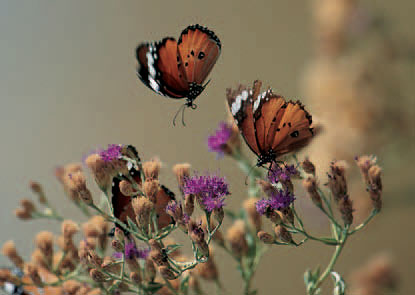
Found throughout southern Africa, the African Monarch is mimicked by some other butterfly species because it contains toxins that make it unpalatable to predators, which then leave it alone.

Sunbirds tiny size allows them to move around bunches of flowers, sipping nectar from each blossom and obligingly spreading pollen from plant to plant (above right: Marico Sunbird; above left: Variable (Yellowbellied) Sunbird).
Next page

